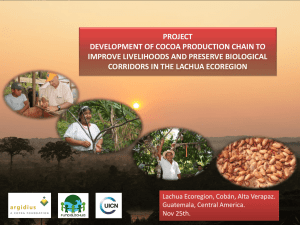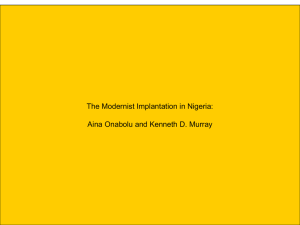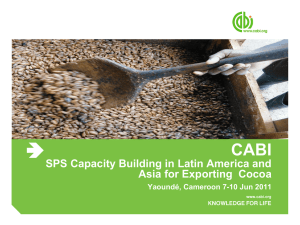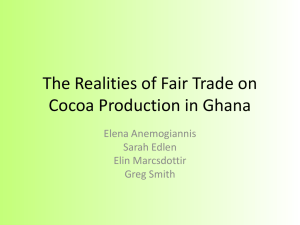Climate Change and Cocoa Output: Evidence from CCR
advertisement
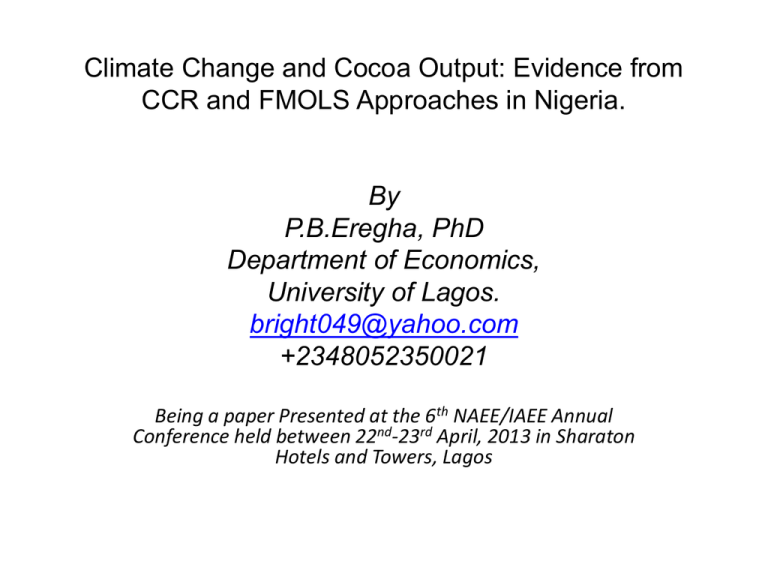
Climate Change and Cocoa Output: Evidence from CCR and FMOLS Approaches in Nigeria. By P.B.Eregha, PhD Department of Economics, University of Lagos. bright049@yahoo.com +2348052350021 Being a paper Presented at the 6th NAEE/IAEE Annual Conference held between 22nd-23rd April, 2013 in Sharaton Hotels and Towers, Lagos Outline of Presentation • • • • Problem Statement & objective Theoretical Consideration & Model Results Conclusion Problem & Objective • • • • • • • • • (IPCC) stated that climate change is emerging as one of cardinal challenges of the 21st century (APF, 2007). concentration of greenhouse gases (GHGs) in the atmosphere and food insecurity are two closely related threats facing mankind (Human Induced). Climate change due to anthropogenic factors has shown that the globe is warming (Odingo, 2009, IPCC, 2007). Studies have shown that the trend is accelerating such that the average temperature is rising at 0.20C every decade (IPCC, 2007 and Ofori-Boateng, 2012). With the rising level in temperature globally, local rainfall patterns are changing, ecological zones are shifting, the seas are warming and ice caps are melting (IPCC, 2007). African countries and other developing countries have been termed to have at disadvantage as the tropical areas stand to experience some of the most severe effect from climate change agriculture which takes a significant part of employment and food provision is the most sensitive to climate variability. Agriculture remains the mainstay of the majority of households in Nigeria and is a significant sector in Nigeria’s economy. Cocoa is one of the leading crops in Nigeria & if agriculture is more prone to climate change. Problem Statement & Objective Cont’d •Cocoa production in Nigeria is threatened with recent trend in global warming. •It is against this backdrop that this study examines cliimatic effect on cocoa output in Nigeria. •Mendelsohn and Dinar (1999), Mathauda et al. (2000), Torvanger et al., (2004), Kabubo-Mariara and Karanja (2007), For Nigeria: Agboola and Ojeleye (2007) , Ayinde et al., (2011) , Jidauna et al., (2012), Sowunmi and Akinola (2010);however, followed Ricardian Approach and the output or production models never captured core variables and besides the methodologies… •hence this study contributes to this literature by using the CCR & FMOLS approaches. Theoretical Consideration and Model •Basically, Four theories linking climate change to crop production: •Ricardian theory •Crop Yield response theory •Agricultural Investment Portfolio Model •Metaeconomics Theoretical Model Model Follows the Crop Yield response theory which allows for weather influence on crop production (Angstrom, 1936) Based on that we specify our model as: (1) y f (l , k , p, t ) Model Cont’d • Where, Y=output of cococa production L=labour proxied by active population in agriculture K=capital proxied by fertilizer import P=precipitation T=temperature Method of Analysis several estimators are proposed in the presence of cointegration: OLS, Fully Modified OLS (FMOLS), Dynamic OLS (DOLS) and the Canonical Cointegration regression (CCR). CCR & FMOLS: These estimators correct the standard OLS for serial correlation and endogeneity of regressors that are normally present in a long-run relationship (Pedroni 1996;Bangake and Eggoh, 2011). Data Source: FAO Database online. Fig 1: Temperature in Nigeria 45 1800 40 1600 35 1400 30 1200 25 1000 20 800 15 600 10 400 5 200 0 0 Temp 1969 1971 1973 1975 1977 1979 1981 1983 1985 1987 1989 1991 1993 1995 1997 1999 2001 2003 2005 2007 2009 1969 1971 1973 1975 1977 1979 1981 1983 1985 1987 1989 1991 1993 1995 1997 1999 2001 2003 2005 2007 2009 Trend Analysis Fig 2: Precipitation in Nigeria Precip 1969 1970 1971 1972 1973 1974 1975 1976 1977 1978 1979 1980 1981 1982 1983 1984 1985 1986 1987 1988 1989 1990 1991 1992 1993 1994 1995 1996 1997 1998 1999 2000 2001 2002 2003 2004 2005 2006 2007 2008 2009 Trend Analysis Cont’d Fig 3: Cocoa Output in Nigeria 600000 500000 400000 300000 200000 100000 0 Cocoa Empirical Results Unit Root Result Table 2: Cointegration Result rank MaxEigen statistics Trace Statistics prob r≤0 39.73 (0.02) 100.04 0.006 r≤1 31.25 (0.04) 60.31 0.01 r≤2 18.57 (0.24) 29.06 0.18 Table 1: Unit Root Results Note: * significant at 1% with intercept and no trend assumption. Variables ADF(1) PP(1) Rmk Population in Agric -4.87* -4.99* I(1) Fertilizer import -6.63* -6.63* I(1) Precipitation -5.06* -6.18* I(1) Temperature -3.49** -3.59** I(1) Cocoa output -10.07* -10.33* I(1) Emprircal Result Cont’d Table 3: CCR and FMOLS Results Population in agric (+) Fertilizer import (+) Precipitation (-) not significant Temperature (-) significant Precipitation had a marginal effcet but temperature had a detrimetal effect to cocoa production in nigeria. Variables Population in Agric CCR Coefficients 0.009** FMOLS Coefficients 0.01* Fertilizer import 0.37* 0.43* Precipitation -11.71 -23.31 Temperature AR(-1) -15648.43** 13446.45*** 0.63* 0.58* C 112505.3 165934.7 Adjusted R2 0.84 0.85 DW Stat 2.27 2.12 Conclusion • The main climatic variables :temperature and precipitation; show that Temperature in nigeria is detrimental to Cocoa production but precipitation is insignificant though negative. • Therefore, it pertinent for authorities to educate farmers to adapt to this worrisome climate change syndrome, investment in proper irrigation infrastructure to enhance cocoa output is necessary. Cocoa shades also required as safeguard to boast cocoa yield.


